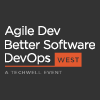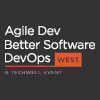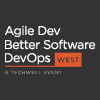Design & Code
Conference Presentations
 |
Engineering for Compatibility
Slideshow
Modern software development has brought us an incredibly powerful tool: continuous integration and deployment. However, taking advantage of this new system isn’t always straightforward. With powerful new tools come powerful new ways of making mistakes that can take your product down in a heartbeat. Melissa Benua has years of experience making CI and CD work for her, with lots of insights—both good and not so good. Come and learn from her as she shares key tips and tricks for coding and testing for both forward and backward compatibility in software releases. Useful for both traditional testers as well as combined engineers, Melissa provides technical and actionable advice to enable your team to make the right trade-offs and the right time investments, allowing your product to release to your customers safely and successfully. |
Melissa Benua
|
 |
No More Shelfware—Let’s Drive
Slideshow
When Isabel Evans learned to drive a car, she also learned how to check, clean, and change spark plugs, mend the fan belt with a stocking, and indicate speed and direction changes with arm and hand signals. Now, we don’t expect to have to do any of those things; we just drive the car. That’s how test tools and automation could be. Just drive and concentrate on the journey of delivering software continuously—concentrate on engineering the solutions, not on the automation. To be effective engineers, we need the support of a powerful toolset that we understand. Is that what we have? Or do we still have shelfware sitting around expensively doing nothing, because we don’t know how to "clean the spark plugs"? Can we remove the difficulties and make using test automation a better experience, just like driving a car? |
Isabel Evans
|
 |
Building a Modern DevOps Enterprise Testing Organization
Slideshow
The DevOps movement is front and center across enterprises. Companies with mature systems are breaking down siloed IT departments and federating them into product development teams and departments. Testing and its practices are at the heart of these changes. Traditionally, development organizations have been filled with mostly manual testers and a limited number of automation and performance engineers. Adam Auerbach says this has to change. To keep pace with development in the new “you build it, you own it” environment, testing teams and individuals must develop new technical skills and even embrace coding in order to stay relevant and add more value to the business. Based on his experiences at Lincoln Financial and Capital One, Adam explores what the DevOps movement is all about, its core values, and proven patterns for how testing must evolve. |
Adam Auerbach
|
 |
What's an API and How Do I Test It?
Slideshow
API-based applications have become ubiquitous in the past few years. Yet many of us still really don't know what an API is from the inside out. Moreover, many of us don't know much about how to comprehensively test them! Join Paul Merrill to learn what everyone is doing and talking about, related to APIs: microservices, REST, endpoints, requests, request methods, and responses. Paul demonstrates four free tools you can use to directly interact with a simple API: curl, the browser, Postman, and Java (with Rest Assured). Learn techniques for testing APIs at the service level and how to test APIs faster with greater coverage and quicker test automation. Walk away with an understanding of what JSON is, how APIs use JSON, and how to go about verifying that it is correct. With new knowledge and skills, you’ll do a better testing job and give more valuable feedback to the API designers and developers. |
Paul Merrill
|
 |
Troubleshooting and Understanding Modern Systems: Tools Testers Need
Slideshow
Successful agile testers collaborate with programmers as code is written, isolating problems, troubleshooting defects, and debugging code all along the way to getting the product to done. But modern systems are scaling beyond what traditional teams are able to understand using familiar tools. New appreciation for systems and complexity theory, as well as disciplines and tools around emerging areas such as observability and resilience engineering, are offering solutions that allow teams to actively debug their systems and explore properties and patterns they have not defined in advance. Chris will share the basics of the theory of these new ideas, as well as some tools that support this type of work. He'll show how dynamic analysis can be used to isolate and understand puzzling system behavior. |
Chris Blain
|
 |
Automation and Test Strategies to Save Our Project from the Brink of Collapse
Slideshow
Teams are sometimes asked to turn a mess of undocumented, poorly structured legacy code into a robust product under impossible deadlines. Test strategies blending automation, exploration, and refactoring can help focus development efforts and converge even the most chaotic projects. But, where do you start? Join Jonathan Solórzano-Hamilton as he shows how automation can help drive products into a state of release readiness. Learn how refactoring, test-driven development, SOLID principles, dependency injection, and mocking frameworks help break down complex development problems into actionable chunks to delivering reliable, self-documented, and high-performing products. Jonathan walks you through the concepts of “Single responsibility”, “Open/closed”, “Liskov substitution”, “Interface Segregation”, and “Dependency Inversion”. |
Jonathan Solórzano-Hamilton
|
|
Peer to Peer Session: Solving Your Continuous Delivery Problems
Slideshow
Peer-to-peer Discussion: How Do I Make CD Work in My Environment? Building a successful continuous delivery pipeline is very context specific. Large organizations with legacy code, existing physical environments, regulatory constraints, large monolithic applications, or stove piped organizations often struggle to find a continuous delivery approach that will work for them successfully. If this sounds familiar, this session is for you. Join facilitator Lee Eason as conference participant’s work together to identify and solve difficult continuous delivery challenges. Learn how other participants and speakers have dealt with the issues you have within their own companies and how you can apply their lessons learned. Share your successes and help others solve their DevOps problems. Expand upon questions you’ve asked during others sessions so you leave the conference with even more ideas for addressing your CD challenges. |
Lee Eason
|
|
 |
I, Project Manager: Meet the Future of AI Software Delivery
Slideshow
[video:https://www.youtube.com/watch?v=nIuO9-eODZs&feature=youtu.be width:300 height:200 align:right] |
Rachel Burger
|
 |
The Impact of Agile Quantified
Slideshow
For years, people have made recommendations for how to develop software in an agile way based almost entirely on intuition, folklore, and anecdotes. They've never been able to quantitatively show the accuracy or applicability of these recommendations. This session quantifies those recommendations in the most precise and objective terms, including a presentation of general findings in Larry Maccherone's research correlating agile practices to performance along the dimensions of productivity, predictability, quality, and time to market. These data can be used to make general decisions about what to focus on. The presentation also includes the numbers, so that instead of just saying that A is better than B, we can say that A is a 24 percent improvement in quality but a 10 percent reduction in productivity compared to B. |
Larry Maccherone
|
 |
Product Delivery Powered by Continuous Integration: A Case Study
Slideshow
Are you a developer who wants to easily manage and customize continuous integration and delivery? Do you work in a team environment where everyone collaborates and depends on CI for automation and delivery of clean code to production? In this session, Amit Mishra will share a case study of how Credit Karma evolved from a single, standalone CI instance to a self-service, Dockerized CI infrastructure combined with bots, webhooks, and GitHub APIs. He will cover GitHub's features and powerful APIs that were most valuable in this process, and how using GitHub freed up time previously spent on maintaining the underlying infrastructure. Credit Karma’s development teams are now empowered to spin up their own CI instances and add custom checks as part of their CI process to ensure quality code. This allows teams to focus simply on developing and delivering services. |
Amit Mishra
|


